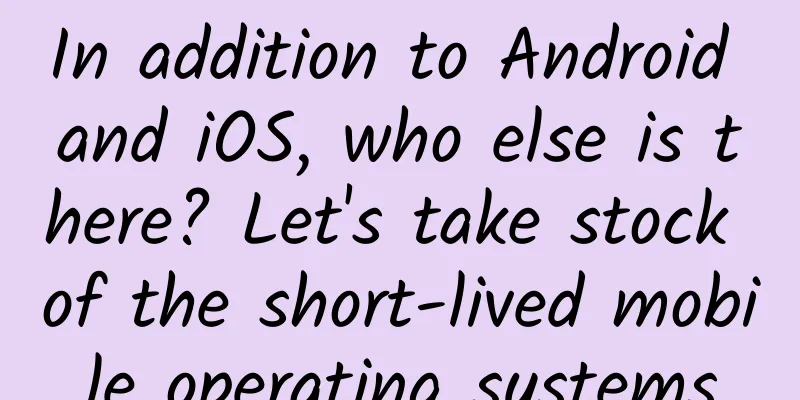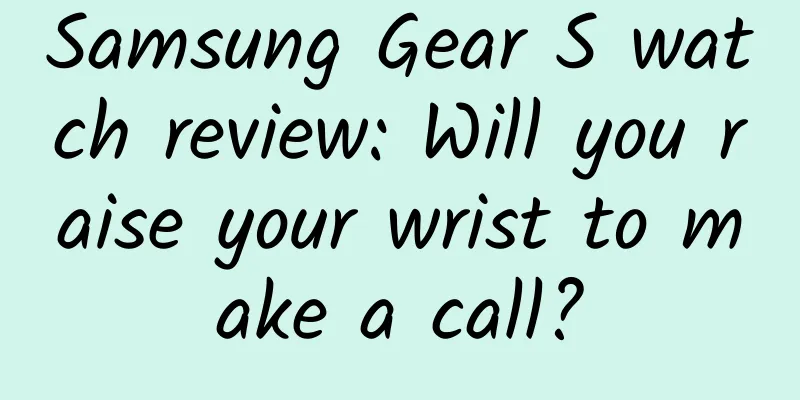In addition to Android and iOS, who else is there? Let's take stock of the short-lived mobile operating systems

|
On January 9, 2007, with the release of the first generation of iPhone, iOS was officially introduced to the public. Also in 2007, Google released the Android system. Since then, the mobile phone industry has been dominated by the two giants, iOS and Android. During this period, other operating systems also wanted to get a piece of the pie, but they all ended in failure. Let me give you an inventory of the ups and downs of other mobile operating systems during the period of the two giants. (Note: Cloud OS, Fire OS and the last version of Symbian are not within the scope of discussion) MeeGo (development has stopped) MeeGo is a Linux-based operating system that uses source code from Intel Moblin (Mobile Linux) and Nokia Maemo. Moblin is a Linux-based operating system built by Intel around its own Atom processor. Its main hardware platforms are MID (Intel's "mobile Internet device"), netbooks and mini PCs. Maemo is Nokia's mobile operating system, which was used on Nokia 770 tablet, N800 tablet, N810 tablet and Nokia N900 smartphone. At MWC in February 2010, Nokia and Intel officially announced the merger of Moblin and Maemo and launched a new mobile operating system, MeeGo. Nokia, which had already given up Symbian, wanted to make MeeGo the main operating system for its products. But just one year later, Nokia announced that its products would use Microsoft's Windows Phone 7. MeeGo was "ruthlessly" abandoned. Nokia's N9 and N950 are the only two MeeGo phones, and the N950 is not yet available to the public. MeeGo system's iconic black background and rounded icons Windows Phone The first version of Windows Phone (abbreviated as WP below), WP 7, was released at MWC on February 15, 2010. It is the successor to Microsoft's Windows Mobile operating system. As soon as WP7 was launched, it attracted Nokia, which was desperate to try any possible means. On February 11, 2011, Nokia announced its cooperation with Microsoft to use WP as the operating system for Nokia products. In the early stage of the cooperation, WP aimed at Android and iOS, hoping to achieve a "three-legged tripod" situation, but the market did not buy it. Under the terrifying dominance of Android and iOS, few developers were willing to develop applications for WP. The lack of application quality and quantity made the WP mobile phone experience poor. This led to a further decline in WP's market share, and then more developers abandoned WP. This vicious cycle not only ruined WP, but also ruined Nokia, which had top hardware design capabilities. On October 9, 2017, department head and vice president Joe Belfiore announced on Twitter that Microsoft would no longer launch new features and hardware for the WP system, and WP was no longer the company's focus. So far, we can completely sentence WP to death. Bada and Tizen Bada is a mobile operating system independently developed by Samsung Electronics. Its competitors in the early stages of development were Android, iOS and WP. But reality is always crueler than expected. With Bada's development in a slump, Samsung, not wanting to be led by Google's Android, began looking for a new way out. At the same time, Intel's partner Nokia also abandoned MeeGo. So Samsung and Intel, the "brothers in distress", started to cooperate and integrated their resources to create Tizen. Tizen V1.0 was officially released on April 30, 2012. Samsung then launched four Tizen smartphones, several smart cameras and smart wearable devices. The last Tizen-powered phone was the Samsung Z4, which was released on May 15, 2017. Samsung's Tizen-powered phones all used outdated hardware, and coupled with the lack of a good reputation for the Tizen system, it was not surprising that sales were poor.
No matter how much influence Samsung has in the industry, it cannot shake the position of Android and iOS. But Samsung has not given up on Tizen. Although Tizen phones may not appear in the future, Samsung's smart wearable devices are still using the Tizen system. Sailfish OS Sailfish OS, or Sailfish OS in Chinese, is another derivative of Nokia's abandonment of MeeGo. Some employees of Nokia's original MeeGo team disagreed with the company's decision to abandon MeeGo, and collectively left to form a new company, Jolla, and developed the Sailfish OS. Therefore, Sailfish can be seen as the sequel to MeeGo. Sailfish OS has redeveloped some system components based on MeeGo, including a new UI design. In addition to its own applications, Sailfish OS can also run MeeGo applications and some Android applications. However, compatibility issues exacerbated the shortage of apps. Jolla's business situation deteriorated day by day, the company was in crisis, and the hardware foundry was also in trouble. Sailfish OS and Jolla phones/tablets were never able to enter the market. At MWC in February 2017, Jolla announced a partnership with Sony Mobile to adapt Sony Xperia X to Sailfish OS. But it didn't help, because the Xperia X is arguably the worst phone Sony has made in recent years. Other phones that support Sailfish OS are even worse, all from small companies that could go bankrupt at any time. The lack of a decent hardware partner has further pushed Sailfish OS to the edge of the cliff. Ubuntu Touch Ubuntu, generally translated into Chinese as "Ubantu", is a Linux-based PC operating system that is extremely popular among developers. Ubuntu Touch can be seen as a mobile version of Ubuntu. It should be noted that Ubuntu Touch and Ubuntu Mobile are not the same thing. The former is a system built specifically for touch-screen mobile devices, while the latter is a system built for Intel MID devices. Ubuntu Mobile has already stopped development in 2009. Ubuntu Touch is closely related to MeeGo and Maemo. The touch UI and some software frameworks of Ubuntu Touch are developed based on MeeGo and Maemo. So far, only five Ubuntu Touch devices have been released. The four smartphones are BQ Aquaris E4.5, BQ Aquaris E5, Meizu MX4 Ubuntu Edition and Meizu PRO 5 Ubuntu Edition. There is also the BQ Aquaris M10 tablet. BQ is a Spanish manufacturer that sells its products only in a few European and Asian countries, and Meizu has little presence outside of China. The lack of product quantity and sales range makes it difficult for Ubuntu Touch to survive. On April 5, 2017, Mark Shuttleworth, CEO and founder of Ubuntu developer Canonical Ltd., announced that the company would end support for Ubuntu Touch. Subsequently, UBports announced that it would take over Ubuntu Touch and continue to provide technical support for the system. However, no matter how much support the developer community gives, Ubuntu Touch still has a hard time breaking into the mainstream consumer market. webOS Now, webOS, which belongs to LG, is the operating system for LG's own smart TVs, smart refrigerators and smart projectors, but webOS was also previously an operating system for smartphones. In January 2009, Palm released webOS, the successor to Palm OS. Palm is a mobile phone company founded in 1992. The company has produced many epoch-making PDAs and smartphones, but unfortunately Palm did not keep up with the pace of iOS and Android. In April 2010, Palm and its webOS were acquired by HP. After the acquisition, HP changed webOS to an open source system, and the later Open webOS was born. On February 25, 2013, HP authorized LG to use webOS on its products, and LG obtained the right to use all resources including webOS source code. In 2014, HP sold webOS to Qualcomm. Now we can only see webOS on LG's smart appliances. Firefox OS (development has ceased) Firefox OS is an operating system for mobile devices developed by Mozilla. The system is based on the Linux kernel and uses the Gecko kernel of the Firefox browser. The phones that run or are compatible with Firefox OS are all low-end phones, and this strategy has prevented the system from getting rid of its cheap label. The pitiful number of device activations makes Firefox OS completely unattractive to APP developers. Faced with this situation, Mozilla had to stop developing the system in September 2016. FireFox OS system interface After development was stopped, FireFox OS spawned B2G OS, H5OS, KaiOS and Panasonic's smart TV system My Home Screen. BlackBerry 10 BlackBerry acquired QNX in April 2010, thereby obtaining its Unix-like QNX operating system. BlackBerry developed the BlackBerry 10 operating system based on the QNX operating system. The first phone equipped with BlackBerry 10, the BlackBerry Z10, was launched in January 2013 and attracted a lot of attention at the time. The BlackBerry 10 system itself is already very good, but like other operating systems other than Android and iOS, the low number and quality of apps still led to the failure of BlackBerry 10. A few days ago, BlackBerry officially announced that it would shut down several key services of the BlackBerry 10 system by the end of 2019 and switch completely to Android. Conclusion These mobile operating systems that have been eliminated from the market have three things in common.
Therefore, the future smartphone market will still be dominated by Android and iOS, and other operating systems can only develop on platforms such as keyboard feature phones, smart homes, and smart wearable devices. |
<<: Aiti Tribe Stories (34): Self-cultivation of a full-stack engineer
Recommend
Can you travel around the world with just a stretch of your hand? Palm recognition is more useful than face recognition!
□ Popular Science Times reporter Chen Jie Stretch...
Data Report | Is automotive industry promotion ineffective? See how peers invest...
During the period of 2011-2017, the scale of Chin...
This article will guide you from 0 to 1 to build an overseas operation and promotion system!
How to build an overseas operation and promotion ...
108 Internet Marketing Tools/Websites
Ever since the Wei Zexi incident broke out last y...
In the US presidential election, how do social media platforms show their power?
In the end, Trump won the US presidential electio...
AiKop | It is said that if you understand these, you will understand the early history of human navigation
Since ancient times, the mysterious ocean has att...
Is there really another "me" in the world? Digital twin: I am
Produced by | Science Popularization China Author...
What are the functions of the Lanzhou Auto Mini Program? How much does it cost to develop a WeChat car mini program?
In 2021, China's car ownership will reach 350...
Google App Ads campaign, ad placement!
In August, Google officially released the latest ...
Taking "Tencent Game Manager" as an example, let's talk about user growth!
1. Market Background By thinking about and analyz...
8,700 words of detailed explanation, guide to building a new media matrix!
With more and more new media platforms, such as W...
Apple encourages users to upgrade to iOS 15: The option to stay on iOS 14 has been cancelled
For users still running iOS 14, Apple is encourag...
Kashgar Mini Program Agency, how much does it cost to be an agent for a lighting mini program?
What is the price of being an agent for the Kashg...
Do you know the real reason why lithium battery performance deteriorates?
Lithium-ion batteries are now widely used in mobi...
How do agricultural input companies conduct marketing through the Internet?
Do you still remember the slogan "I won’t ac...









